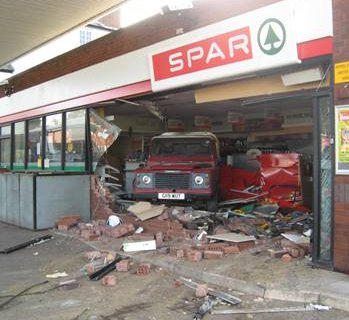Difference between revisions of "Security issue: Ram raid"
| Line 9: | Line 9: | ||
<ref>http://www.youtube.com/watch?v=z5uvkfoghUo</ref>Notably, large trucks are used to break into technology companies and steal high-value equipment for resale on the [[wikipedia:black market|black market]]. |
<ref>http://www.youtube.com/watch?v=z5uvkfoghUo</ref>Notably, large trucks are used to break into technology companies and steal high-value equipment for resale on the [[wikipedia:black market|black market]]. |
||
| + | |||
| + | Out of town retail parks and industrial parks are often targets due to their largely deserted nature after day time business hours, together with the relatively high-value products often on sale (e.g. electronics). |
||
| + | |||
| + | In recent years, ram raiding with excavators/diggers to target ATM machines, has risen significantly<ref>for example in July 2012 (UK example): http://www.bbc.co.uk/news/uk-england-suffolk-19026835</ref>. |
||
== Attributing circumstances == |
== Attributing circumstances == |
||
Revision as of 11:28, 7 December 2012
Contents
Security issue: Ram raid
Ram raid is a particular technique for commercial burglars to gain access to primarily commercial premises, by means of driving -usually stolen- vehicles into locked or closed entrances, exits or windows.
Description
This act has occurred since at least the mid 1930s. The term came into widespread use after a series of such raids in Belfast in 1979 that was covered in news reports and in countries such as Australia that inspired a series of similar crimes.
[1]Notably, large trucks are used to break into technology companies and steal high-value equipment for resale on the black market.
Out of town retail parks and industrial parks are often targets due to their largely deserted nature after day time business hours, together with the relatively high-value products often on sale (e.g. electronics).
In recent years, ram raiding with excavators/diggers to target ATM machines, has risen significantly[2].
Attributing circumstances
- proximity
- protection level in surrounding areas
- no relation with drugs or ethnicity
- lie of the area: travel to less-security conscious areas (satelite towns around cities)
- type of commercial enterprise
- limited planning, high degree of
- young perpetraitors
Socioeconomic circumstances
Although there is no real scientific consensus with respect to the causal relationship between the socio-economic background and property crime like robberies or (ram)raids, Australian research, for example, illustrates that long term unemployment amongst young male adolescents has a substantial effect on property crime rates[3].
Enthorf and Spengler(2002)[4] find that planning-intense offences like breaking and entering, robbery (ram raids) and violence respond relatively slow to changes in the socio-economic conditions compared to other types of crime like drug and alcohol abuse and violent crime. According to the authors, this may reflect that in a first response to unfortunate social and economic developments some of the affected might become attracted to alcohol and drug abuse, which in a later phase has to be financed with criminal activities by committing property crimes like breaking and entering.
Impacts
Economic impact
Ram raids lead to considerable costs in both a direct (primary) and a indirect (secondary) way[5]. Direct costs of ram raids come in the form of:
- Preventive costs in anticipation of ram raids (e.g. security measures, insurance);
- Material and immaterial costs as a consequence of ram raids (e.g. physical damage, repairments, medical costs, mental harm); and
- Responsive costs to ram raids (e.g. the costs of detection and prevention, persecution, support trial, etc.).
In addition, the secondary economic impact of criminal offences has to be considered. Violent crime not only leads to financial or physical damage and prevention costs, but also indirectly influences the local/regional and national economy of a country. According to Detotto and Otranto [6],“crime acts like a tax on the entire economy: it discourages domestic and foreign direct investments[7]. On a more local and regional level, economists define economic impact on business, property value, tourism and quality of life (social capital).
Measures

Commercial properties in areas prone to ram-raids often erect strong barriers or obstructions, such as bollards, to discourage such attacks. ATM centres are also victims of ram-raiding.
Many companies have come up with solutions to ram-raiding.[10] Everything from electronic bollards to electronic barriers have been employed to keep property from the raiders. Another solution is security guards, but teams of "round the clock" security are expensive and often not the most economical way of dealing with ram-raiding.
Footnotes and references
- ↑ http://www.youtube.com/watch?v=z5uvkfoghUo
- ↑ for example in July 2012 (UK example): http://www.bbc.co.uk/news/uk-england-suffolk-19026835
- ↑ See, e.g.: Chapman, B., D Weatherburn, C.A. Kapuscinski, M. Chilvers and S. Roussel (2002). Unemployment duration, schooling and property crime. CEPR Working paper
- ↑ Entorf, H., H. Spengler (2002). Crime in Europe; Causes and Con-sequences. Springer-Verlag Berlin
- ↑ Primary economic impact (or direct effects) are generally defined as the initial, immediate economic output generated by a specific cause (in this case a criminal offence). Secondary economic impact (or indirect effects) are generated each time a subsequent transaction is made, for example, the impact of crime on the real estate value in the neighborhood.
- ↑ Detotto,C. and E. Otranto (2010). Does crime affect Economic growth? KYKLOS, Vol.63–August 2010-No.3, 330-345.
- ↑ Foreign direct investment (FDI) is a direct investment by a business or enterprise in a foreign economy.
- ↑ add specific measures
- ↑ add specific measures
- ↑ 'Raminator' foils ATM ram raids. The Daily Telegraph. 21 Aug. 2008.
MAP
<websiteFrame> website=http://securipedia.eu/cool/index.php?concept=Security issue: Ram raid width=100% border=0 scroll=auto align=middle </websiteFrame>
<headertabs/>
